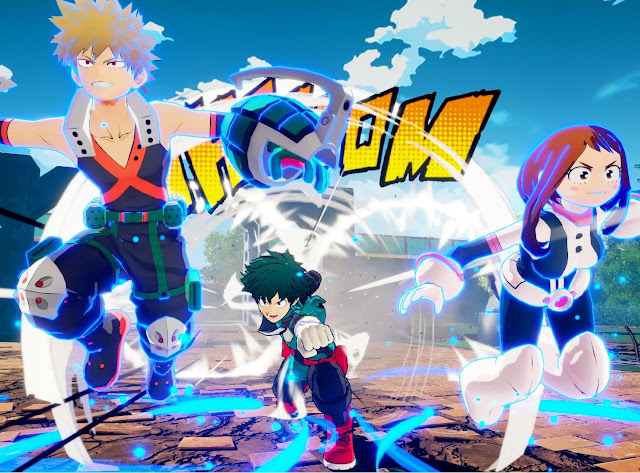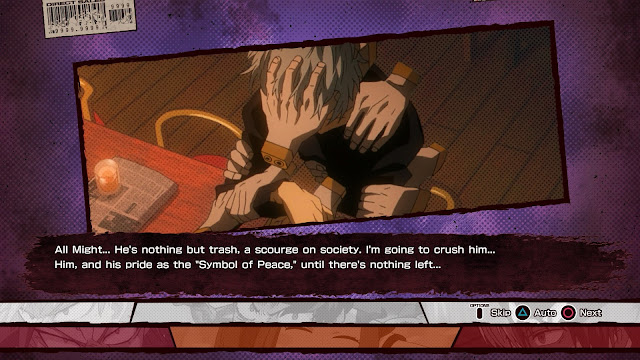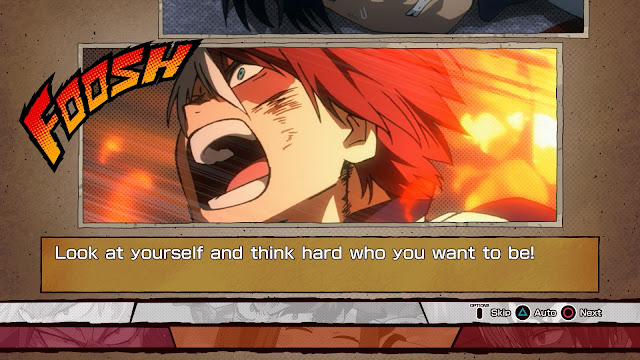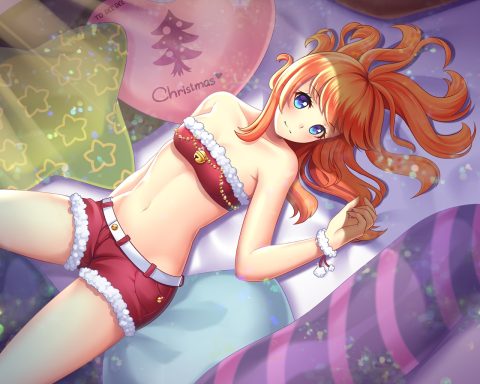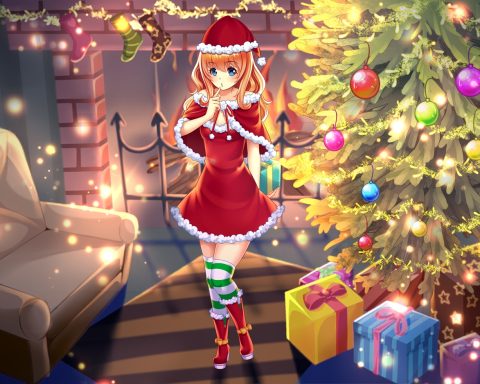– Clark A.
Anime Editor
Review: My Hero One’s Justice (Sony PlayStation 4)
Review by Clark A.
Fresh off its first feature film, heading into its fourth season, and over 200 manga chapters deep, My Hero Academia is a full-fledged phenomenon. My Hero One’s Justice, an anime arena fighter, is a logical extension of author Kohei Horikoshi’s ongoing scheme to conquer the entertainment world. One’s Justice might not tap into everything that the franchise stands for, but it’s one for all fans of the series.
Many point to Horikoshi’s leverage of tried and true themes and settings like superpowers and high school as reasons for My Hero Academia’s ascension. The series has a battle shounen structure but is influenced by every western superhero comic under the sun and even films such as Star Wars and Alien. That said, it’s the implementation of existing concepts that allows a series to sink or swim. Academia no doubt outweighs surface level appeal or the sum of a trope list.
The series really does pull you in from the get-go. We’re shown the story of Izuku Midoriya, a fanboy of the world’s greatest superhero, All Might. Born without superpowers in a world where 80 per cent of the population has been endowed with them, Midoriya’s only daily battles are emotional ones. His aspiration to be a professional hero won’t falter just because he happened to be born the wrong way. Even after miraculously receiving powers from his idol however, Midoriya needs nearly a year of training his human body and anime montages galore just to qualify for a school that will teach him how to be a hero.
Thus, Midoriya transforms from the target of sympathy to underdog extraordinaire. You’ve got this compassionate, hardworking kid with immeasurable potential clawing at the air just to keep up with classmates that have reflexively used superpowers for most of their youth. His newfound access to unspeakable power means little when simply using it shatters his bones and mangles his body, an issue his fellow students don’t have. Whenever Midoriya relies too heavily on raw power, he stands to tarnish the most precious gift he’s ever received. Enduring grueling training, acquiring wit, and tapping into his latent bravery will turn him from a burden to his beloved icon’s successor.
The student-mentor relationship Midoriya has with All Might (the aforementioned number one hero) is paralleled by a villainous organisation. Observing how the masters treat their pupils and how Midoriya’s twisted foil develops an increasingly venomous doctrine to be ingested by the masses makes viewers anticipate the future. When the heroes and villains go toe to toe, there’s more at stake than a couple civilians or the lingering effects of punches and kicks. The ever shifting political landscape sizzling in the background threatens to disrupt both heroes and villains, so both vie for the populace’s hearts.
Along the journey, everyone on each side gets charitable screen time for character development. Horikoshi turns even circumstances with little impact on the series’ grander world into opportunities for characters discovering new powers or learning about themselves. If you haven’t read or watched My Hero Academia, though, you’re not going to see much of the above play out in One’s Justice.
Story mode thrusts you into the roles of various characters as you play out the plot of the anime in arena fighter form. You’re regularly given plot-appropriate sidekicks that you can tag into battle. Besides a handful of optional branching missions, it’s a straightforward romp all the way through. Unfortunately, it brushes a great deal of the series under the rug by leaping into the thick of season 2.
Work your way through the main campaign as the heroes and eventually you’ll have the opportunity to play as villains too. Regrettably, most story cutscenes are identical since you’re just fighting on the opposite side of any given conflict. The tournament arc, unlocked after completing both campaigns, actually feels like it should have come first (as it does in the main series). Even though the developers likely wanted to toss players to the wolves with greater stakes, the tournament could have been fleshed out and used to provide character building. Heck, it would increase the sense of escalation. If the developers threw in little video packages for each character and had you play through the whole tournament, subsequent events might actually matter and the villains would boast an extra layer of mystery to them not present in the manga or anime.
A game that recreates parts of the second and third season anime (shot for shot at times) is fighting an uphill battle. A new player has zero investment in Midoriya’s underdog character, the side plots of his friends and rivals, or his mentor weakening. For instance, the heroic Tenya Iida squaring off against Hero Killer Stain for bloody revenge has no impact when you don’t know about Iida’s normally caring, diligent role as a leader to his classmates. I don’t want or expect the entire series to be recreated panel for panel, but extra scenes of the “Academia” portion of the series showing who these budding heroes are outside of violent conflict would allow the action to resonate.
The game does a respectable job of recapping and recreating certain events through comic book panels, but it’s difficult for them to mean much without the basic beginning, middle, and end you’d expect of a story arc. Fans have already seen these bits animated competently to tremendously by Studio Bones. What you’re getting is a tour that goes over the show’s best bits and reenacts iconic fights without a fraction of the context that made them great. I get that this is fairly standard and what some fans of anime games have come to accept, but I feel there’s room for improvement. Considering these games are often playable advertisements to increase manga sales, I do think there could have been a bit more to make those people care. For how well the story is presented, it’s disappointing that a more of it didn’t mean something. Perhaps the decision to drop “Academia” from the game’s localized title was candid marketing.
I must give credit where credit is due, though, because One’s Justice has the world going for it in terms of presentation. The classic American comic book aesthetic is married to modern anime character designs. The game’s menus didn’t need to be anything more than functional, yet they make this game feel premium. Conversation cutscenes are typically simple panning screenshots with action sound effects and dramatic motion effects. Considering Horikoshi’s influences and own art, the presentation could not be truer to the source material. The iconic voice acting brings the characters to life for key scenes, such as Midoriya’s struggle against a villain far stronger than him and All Might’s sorrowful discoveries. It’s a masterful example of style trumping budget.
So while One’s Justice looks the part and plays competently enough, there’s the lingering sense that the developers haven’t actually tapped into the series’ appeal. I understand turning this into a coherent story would have been tricky, but there are alternatives to convey what makes the show exceptional. Let players interact with their classmates between missions (be that through static text, original cutscenes, or a traversable academy) in such a way that their defining traits and relationships are displayed. Suddenly, the 80+ slugfests in story mode will have tangible weight behind them.
Likewise, character growth and self-improvement aren’t particularly reflected by the story or gameplay. The name of the series speaks volumes in that it’s not just about the world of heroes but learning and evolving. It could be as simple as raising and lowering a character’s stats, powering up specific attacks, or even just adding lessons that highlight the importance of certain mechanics. Offer some vehicle by which the player learns and powers up alongside the students. It might be said I’m being unrealistic as I would never expect these things from a My Hero Academia match three puzzler. I’m of the opinion that fighting games can have stories and should have them when it’s logical, however. If the developers didn’t want to embrace that, a few additions and tweaks could have kept the general arena fighter framework intact while selling new audiences on the series and igniting the passion of existing fans.
Thankfully, the combat in One’s Justice holds up its end of the bargain. It’s not far from what you’d see in a Naruto: Ultimate Ninja Storm game, letting you sprint around a 3D expanse while you square off. There are no complex inputs to remember and moves are fairly intuitive to learn for each character once you know the basic controls.
From there, it’s about mastering combos and determining what attack range suits your character offensively and defensively. Frankly, you don’t need to master them for single player, though. Before combat, you’re allowed to pick between normal controls and manual controls (which translate to competitive and button masher modes respectively). Seriously, the normal setting will let you whoop your opponent without having to stop and think about logical combos.
If you want to explore the game’s competitive depth, there’s enough present. There’s a rock-paper-scissors relationship between normal attacks, grabs, and counters that can be exploited to set up character-specific superpowered attacks. The emphasis on blocking is huge compared to some arena fighters and you can even hold off an opponent’s ultimate “Plus Ultra” move by doing so. Depending on the mode, you can tell a sidekick when to launch a sneak attack to set up a combo or save you from a tight spot. Character balance will obviously ebb and flow as patches continue to be released, though I came away relatively impressed.
Stages open up as you fight due to destructible environments, making devastating blows carry more credence. There’s also a mechanic that allows you to fight on the sides of buildings. Though that doesn’t necessarily make sense for every character’s powers, it makes fights with the more agile characters positively climactic.
Not every character’s superpower is effortless to recreate in a playable context, but the developers surely gave it their 1,000,000 per cent. Shouto Todoroki has a clear-cut coolness factor with his dual fire and ice powers that flashily dominate the battlefield. Then there’s the less conventional types such as Himika Toga, who copies fighters and Fumikage Tokoyami, who can attack up close or switch to his shadowy ally. By the time you get to Tsuyu Asui, you’re dealing with a frog girl who lashes out with her long tongue. Then there’s Kyoka Jiro, whose headphone jack earlobes let her weaponise sound as massive speakers pop up beside her mid-battle. The roster is missing certain notable faces, but for a game with 20 playable characters out of the box and more as downloadable content, this more than paves the way for unique matchups.
I do appreciate that the characters have radically different play styles, such as Katsuki Bakugou. He seems worthless when fighting at a distance, but find that sweet spot between mid and close range and suddenly he’s cleaning house. My MVP has to be Denki Kaminari. He conjures fields of electricity that inhibit the movements of opponents and then stuns them to set up combos. In a nod to the show, using too much electricity will short-circuit his brain and render him briefly vegetative. His move set lends itself naturally to experimentation and mind games, yet also punishes players for getting overzealous. One’s Justice lives up to the source material by juggling definitive strengths and weaknesses based on their powers and mobility.
While the battles likely won’t electrify EVO for the next 20 years, they are exceedingly alluring all the same. The ostentatious and occasionally comedic superpowers Horikoshi created come to life in playable form. Whether or not you’ve seen the show, the sheer variety is enchanting enough to garner interest on its own. The added comic book effects and touches like environmental damage make combat feel dynamic and interesting in a way that more conservative games of this genre often do not. There’s a respectable amount of authenticity and attention to detail as far as character representation goes. Deku’s strongest attacks actually mangle his arms as they would in the story and you see him limping around even in victory. Every punch All Might throws feels like the end of the world thanks to the dramatic sound effects and comic book motion lines. With how well the maps and characters are represented here in fighting form, I can see hardcore fans spending hundreds of hours on the online mode. If the casual crowd can look past the paltry story mode, there is something exciting here.
If you don’t much care for mastering online play (which is fair, given its tendency to pair strong and weak players indiscriminately), One’s Justice does present alternatives before running its course. Without a meaningful story or combat that’s as customisable as games like Dragon Ball Xenoverse with its character creator, it feels like something is missing. There’s a decent number of modes to keep fans lightly occupied. Arcade mode is exactly what it sounds like and great for experimenting with new characters in a structured format. Mission mode is a gauntlet that tasks you with surviving several matches in a row on one HP bar but multiple characters to swap between. This mode actually has leveling up, which is disappointing in that it wasn’t fleshed out further to be more customisable like I suggested earlier. It’s still by far the game’s most endearing side mode, though, as it encourages you to play with stamina in mind rather than brawn.
Best of all, most in-game activities will reward you with new character costumes or currency with which to procure them. Considering the slew of campy-yet-charming hero costumes in this series, being able to play dress up with the angsty Bakugou is the next best thing to designing your own hero. You can dress up a hero as a villain or ponder how the levelheaded Izuku Midoriya would look wearing his rival’s bulky gauntlets. Online brawls are all the better fighting against whatever gaudy outfit your opponent is sporting.
In the heat of the moment, My Hero One’s Justice is a playable highlight reel with enough love from the developers to make it feel more substantial than your standard anime fighting game. This isn’t always the case as, beyond the My Hero Academia presentation and fan service, the spirit of the series isn’t quite there. Nonetheless, Bandai Namco now has access to a formula that can be overhauled for years to come. Should sequels never see the light of day, One’s Justice is still excellent comfort food for fans of the series.
Latest Articles
Hello everyone, and Happy Holidays! What a year it has been, too. An impossible number of…
It’s that time of year again! We’re counting down the days to Christmas with our own…
It’s that time of year again! We’re counting down the days to Christmas with our own…
Welcome to Digitally Downloaded’s weekly catch-up news feature, the catch-up coffee. I will bring you the…
It’s that time of year again! We’re counting down the days to Christmas with our own…

